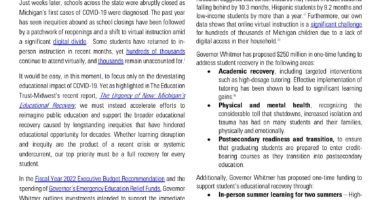New Report: School Funding System Failing to Provide Equal Opportunities

New report: more investment needed for underserved students
Michigan is now in the bottom five states nationwide for equitable school funding, and should take immediate steps to invest much more in students from low-income backgrounds, rural students and other vulnerable students, according to a report released today.
A new report from The Education Trust-Midwest, Michigan’s School Funding: Crisis and Opportunity, shows how the state’s K-12 education funding system is neither adequate nor equitable – with the burden falling hardest on students who have special needs, those in low-income and isolated rural districts, and those who are learning English in school.
“Michigan can learn a lot from the nation’s top education states such as Massachusetts, not only for improving teaching and learning but also for how to create a fair and equitable education funding system,” said Amber Arellano, executive director of The Education Trust-Midwest. “Doing so will boost incomes for graduates, reduce need for government assistance and increase our state’s talent pool for employers.”

See below for notes on reading this figure.
The report notes that while money alone is insufficient for educational transformation, research shows spending increases done well can improve educational attainment, particularly for students from low-income families other underserved student groups. If Michigan’s current K-12 students had educational achievement at the national average, their lifetime earnings could increase by $27 billion, according to the W.E. UpJohn Institute for Employment Research.
Joining other organizations that are calling for Michigan to move to a weighted student funding formula, the report highlights a national report that ranks Michigan in the bottom five states for funding gaps that negatively impact students from low-income families. In addition, another state-by-state funding system review gives Michigan a “D” grade for how well it targets funding to high-poverty districts relative to low-poverty districts.
“Our children deserve better. Our employers are demanding better. Other states are doing better,” said Arellano. “For the sake of our children and our economy, we need to examine the data and follow best practices to create an education finance system that is adequate and equitable for all of our students.”
Key findings
The new report includes an in-depth analysis of the state’s current funding system, as well as evidence-based principles based on leading state practices and research to inform Michigan’s growing conversation about education funding. These include:
- Funding according to student need. Research suggests students from low-income families need at least twice as much funding as those from wealthier families.
- Provide more funding to districts with greater needs. Low-wealth districts need additional funding to address gaps, while making sure that all schools and districts are funded to meet the full needs of their students. Many geographically isolated, rural districts face unique challenges and deserve additional support, as do districts with high concentrations of poverty.
- Ensure school districts are held accountable for additional funding to ensure it reaches the intended students and is spent on research-based best practices that improve student learning.
The report also holds schools and the state accountable by requiring them to do a better job of informing parents, community leaders and other stakeholders – in plain language and using high-quality data that allows comparison between districts – about school funding, the funding districts should receive and do receive, and how it is spent.
Show your support for better school funding and click here to sign the Fair Funding Pledge.
Budgets reflect priorities, so what does Michigan school funding say about our values? Today, Michigan is one of the bottom five states nationwide for equitable school funding. We are failing to provide equal opportunity for student success.
The impact of this fundamental unfairness falls hardest on students with the greatest needs: those from low-income families, new English speakers, special education students and those attending schools that are isolated, or are in areas with high concentrations of poverty or low property wealth.
Our future as a state rests on the shoulders of our children and our children deserve better.
Tell Michigan leaders that you prioritize fairness and opportunity in school funding and urge them to do the same.
Sign the pledge at edtru.st/mipledge
Share new findings
Share these important findings with your network. Connect with us on Facebook, LinkedIn and Twitter, and share about the new report.
![]() Every #Michigan student should have the opp. to succeed in school & life. That’s not happening today. #MichEd funding is not equitable or adequate. New report from @EdTrustMidwest is out now. Read: edtru.st/funding #opp4all (Click to Tweet)
Every #Michigan student should have the opp. to succeed in school & life. That’s not happening today. #MichEd funding is not equitable or adequate. New report from @EdTrustMidwest is out now. Read: edtru.st/funding #opp4all (Click to Tweet)
![]() #Michigan students deserve fair school funding. I just took the pledge. Will you? edtru.st/mipledge #miched #mileg #Opp4All (Click to Tweet)
#Michigan students deserve fair school funding. I just took the pledge. Will you? edtru.st/mipledge #miched #mileg #Opp4All (Click to Tweet)








